Grasses are often overlooked in gardens because most people are thinking more about flowers and less about texture. However, grasses are truly a wonderful addition to a garden. They are capable of fulfilling many different landscaping requirements while providing a bountiful resource for wildlife. If your garden is also for educational purposes, then you might consider planting some or all of the “big four”, the plants that dominated the tallgrass prairies.
In nature, grasses are dominant in sunny areas that are prone to some sort of disturbance. This could include grazing, drought, fire or flooding, Grasses grow differently from trees in that the growth centre is at the base of the plant. When subject to grazing or fire, grasses like many other perennials will grow back from the base of the plant.
| |
 |
|
| |
This meadow is dominated by Fowl Manna grass and is subject to flooding. |
|
Grasses provide birds a place to hide; they provide nesting materials and they provide birds with enormous amounts of seed to eat. Grasses are host plants for many butterflies, particularly skippers, as well as grasshoppers and true bugs.
Grasses also provide overwintering sites for a range of insects.
Large mammals also graze on grasses, but don’t worry if you don’t have too many of them running around your suburban garden. You are not missing out.
| |
 |
|
| |
Big Bluestem in a hydro corridor |
|
Cites in North America have been using hydro corridors to create prairies. It remains to be seen whether the mowing practices used can replace fire management, but in Toronto, the powerlines are one of the few places where you can find Eastern Meadowlarks. A suburban garden will not work for them. They need plenty of land and if mowing occurs, it should be done at the end of the season so that they have time to complete the rearing of their young in nests on the ground.
Grasses can be used as accent plants around your property. They can also be used as the dominant landscaping feature in more formal settings as well as in urban areas. In many urban gardens, there are sizeable spaces between the plants to help show the blooms off which increases the need for weeding, chemicals and the use of mulch. In a typical wildlife garden, grasses are useful in between larger plants where they will block weeds from finding a spot as well as helping show off the larger flowering plants. Importantly, they also provided much needed cover for small animals to survive. In gardens that mimic prairies or meadows, grasses should make up about 50 – 60 % of the plant vegetation. In a typical suburban garden, grasses can be maintained by normal weeding. In larger areas, chemicals will be used to clear the area and mowing will be used to maintain the grassland.
| |
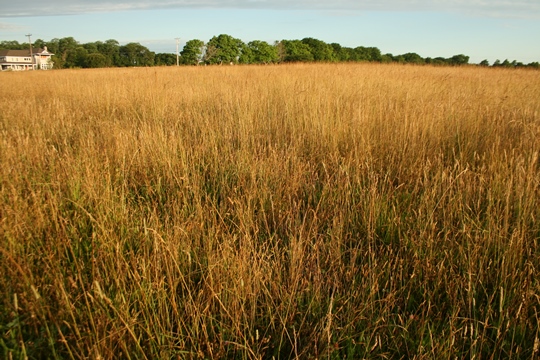 |
|
| |
Prairies and meadows are dominated by grasses. |
|
Grasses are often classified as sod forming or bunch grasses. Bunch grasses spread slowly and form a tight bundle. When planting bunch grasses, you have to be much more careful about the weeding situation especially in the first few years. Eventually, they do fill in the gaps. Sod grasses produce stolons and rhizomes that allow the plants to spread and fill in relatively quickly.
Grasses are also classified as warm season and cool season depending on whether the most rapid growth takes place in the spring or in the summer. Cool season grasses grow when there is more moisture and tend to have shallow rooting systems. They produce seed in early summer. Warm season grasses are more likely to be adapted to drought with roots that extend as much as 10 feet into the soil. They produce seed in late summer or early fall. From a management perspective, cool season grasses are going to need more water to prevent them from going into dormancy during the heat of the summer. From a design perspective, it is considered better to have both cool and warm season grasses growing to provide a full season of interest.
Lastly, it is possible to classify grasses as either tall or short. If you are making a prairie garden, you should really choose one or the other. Any grass under 3 feet in height is regarded as a short grass. In a regular wildlife garden, plants will be positioned according to their height and this will ultimately dictate your choice of plants and where you site them.
Most grasses are easy to grow and in general are not too fussy about soil conditions. They do need lots of sunlight to see them at their very best. They take several years to fill in around them so weeding is necessary in the first couple of years. If you are planting a few specimens within your flower garden, I would highly recommend marking the spot with something that will not become dislodged over the winter. By the time spring comes around, you will forget the exact spot and may end up pulling them out as a weed by mistake.
Which native grass species are good for wildlife?
The following grasses are widely available, have a large natural range and they are also useful for wildlife. Do not assume that all members of the same genus have the same level of wildlife value.
| |
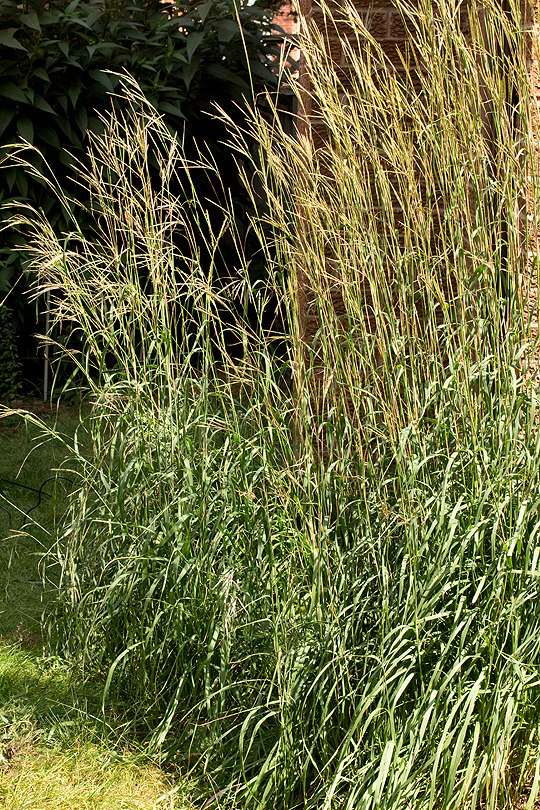 |
|
| |
Big bluestem, with their distinctive seed heads, are great accent plants. |
|
Andropogon gerardii (Big bluestem) 
This is a warm season grass that is slightly sod forming as it produces short rhizomes. It is one of the big four and it supports many different insects. It grows up to 8 feet high and 9 feet down. Its deep roots give it good drought resistance and can grow in any soil type. It has a tendency to flop over, so give it some support. It will flower at the end of the summer after which it will turn to shades of red and brown (Brown 1979).
| |
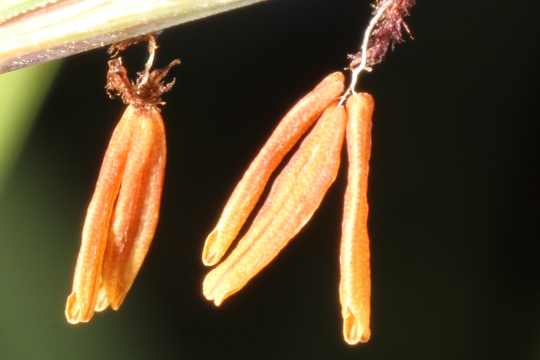 |
|
| |
Big bluestem flowers in late summer. |
|
Andropogon virginicus (Broom sedge) 
This Bluestem is roughly the same size as Little Bluestem and grows in similar locations (Cullina, 2008). While being called a sedge is misleading, it has leaves that remain very stiff when they dry out. It does well in dry sandy soils with little competition and in nature is found in disturbed areas. It is a secondary coloniser. Various insects do feed on the leaves and some birds also eat the seeds. Like Big Blue Stem, this is a warm season grass with limited sod forming ability. It grows to about 3 feet high and 1 foot in width.
Bouteloua curtipendula (Sides oats grama) 
Like Big Blue Stem, this grass is also a warm season grass with good summer drought resistance. It is also slightly sod forming with short rhizomes. However, it is a short grass remaining under 3 feet high. It is highly adaptable when it comes to soil conditions and it can be grown on slopes, but it is best to avoid acidic soils. The plant is named for the distinctive oat-like flowers that hang down on one side of the stem. These plants, due to their size, are often grown en masses, but they can easily be grown between plants, especially tall spring flowers which they help to show off. They support a range of skippers as well as grazing animals.
Bouteloua gracilis (Blue Grama grass) 
An alternative to Side Oats Grama is the smaller Blue grama, which is a bunch grass that typically grows less than two feet high and which does well in a sandy or loam soil. It is possible to get much taller variants that grow up to 3 feet high. The spikelets are distinctive because many of them are held in a near-horizontal position. The spikelets can have a purplish tinge to them which explains the name of this grass. It is quite adaptable and will grow well in most gardens if it is given lots of sunshine.
| |
 |
|
| |
A much taller example of Blue Grama grass compared to the 8 inch specimens in my own garden. |
|
| |
 |
|
| |
Prairie brome is a small grass with large attractive seedheads |
|
Bromus kalmii (Prairie brome) 
This is a cool season grass. Dry summers will make this plant go dormant. It does well in partial shade where it can avoid the dry heat during the summer. The seeds are large and heavy considering the short stature of this plant and therefore droop downwards in an attractive fashion.
| |
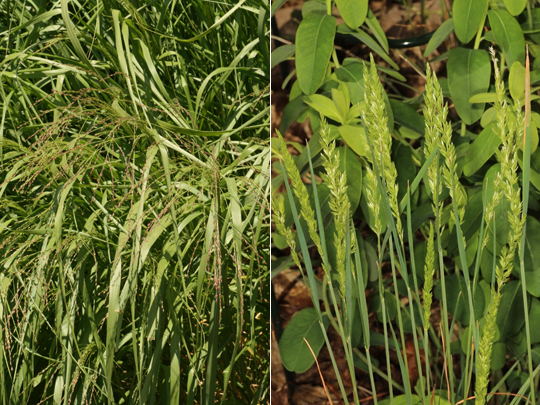 |
|
| |
A thick growth of Switchgrass and the golden flowerheads of June grass |
|
Koeleria macrantha (June grass) 
June grass is a cool season grass that is highly attractive with its large flowerheads. It prefers to grow in full sun in sandy soil. It is less than two feet tall so it can be used in many gardens and it retains it flowerheads for a long season of interest. This grass is drought resistant and can go without water for weeks. This grass would work well with short summer flowering perennials as it may go dormant during the heat of the summer and allowing the flowers to fill in. I grow mine with flowering spurge; otherwise, monarda punctata would also work well.
| |
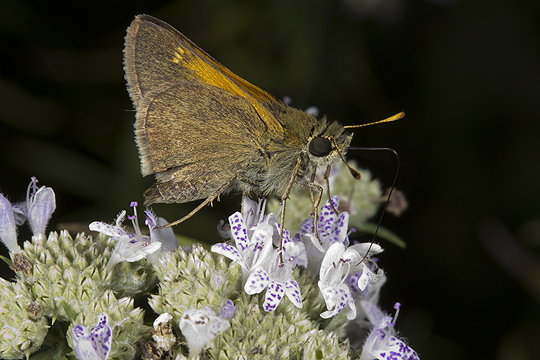 |
|
| |
Switchgrass is a host plant for at least 7 different skippers. The tawny-edged skipper shown here is one of them. |
|
Panicum virgatum (Switchgrass) 
Switchgrass is another member of the big four. It is also the most adaptable in that it can tolerate most soil conditions including elevated levels of salt along roadsides. It forms a dense clump that serves as excellent cover for birds. It provides foods for many grain eating birds as well as leafhoppers and skippers. It is a warm season bunch grass that grows up to seven feet high. To appreciate this grass, you need a large clump or you have to grow it en masse.
| |
 |
|
| |
A stand of switchgrass |
|
| |
 |
|
| |
Switchgrass beautifully integrated into a small backyard wildlife garden behind a raised deck. |
|
Sorghastrum nutans (Indian grass) 
Indian grass is a warm season grass that grows up to 7 feet tall depending on the soil conditions. It is popular with grasshoppers and skippers and it feeds birds. It has a noticeable golden inflorescence and in my opinion is the most beautiful member of the big four. It is a sod forming grass, but it has short rhizomes and does not spread aggressively.
| |
 |
|
| |
Indian grass looks absolutely fantastic while it is in flower. |
|
| |
 |
|
| |
As the grass ages through the season, the seedheads that develop become more golden. |
|
Schizachyrium scoparium (Little bluestem) 
Despite the name this grass can still grow over 4 feet high. Little blue stem is the shortest of the big four and this actually makes it easier to site in many small wildlife gardens. Its leaves can have a variety of hues and some cultivars are available with a strong blue-green or reddish colour. It can work very well as a standalone specimen or en masse. Little bluestem is a bunchgrass but given enough moisture the grass can send out rhizomes and become sod forming (Brown 1979). This grass is a warm season grass with fibrous roots. It is an excellent forage plant that also feeds many different skippers and grasshoppers. The seeds are also used by birds.
Sporobolus heterolepis (Prairie dropseed) 
Prairie dropseed is a short warm season bunch grass that grows wider than it does vertically. The texture of this plant is attractive and as such it can be grown as a monoculture or as a specimen plant. It only grows about 2 feet tall so it is a good grass to grow in small borders or at the front of larger borders. It is not recommended to plant Prairie dropseed in clay soils and it can easily handle a drought in sandy soils. The plant lives a long time and serves as a source of food for a range of sparrows. Sporobolus cryptandrus (Sand dropseed) is a suitable larger alternative for dry sandy soils and can grow as much as 3 feet high. As is typical of drought tolerant grasses, it has very deep roots considering its size, which may reach up to 8 feet beneath the surface.
Grasses suitable for rapid colonisation
The grasses mentioned so far are excellent in meadow plantings but grow relatively slowly. In newly made beds or meadows, it is useful to plant grasses that spread quickly to fill in the gaps. Initially, these plants may dominate your planting, but as time goes by, the bunch grasses will outcompete the colonisers and take over. By allowing this successional process to take place, you can cut down on weeding when installing a new bed of grasses or a meadow. These grasses would not be suitable in a mixed border.
Agrostis hyemalis (Ticklegrass) 
This cool season bunchgrass grows to about 3 feet high and is quite adaptable so it is easy to grow. It flowers in the spring and produces purplish seed heads that may break off. This grass can spread by stolons and can be used a lawn substitute. Like other grasses, it is a hostplant of several species of butterfly. Both Ticklegrass and the similar Agrostis perennans (Upland Bent Grass) are candidates for acting as a living mulch.
Ammophila breviligulata (American Dune Grass) 
This grass is definitely not ideal for a mixed border even if you have the dry sandy soil that it needs. It has rapidly spreading rhizomes and it needs this adaptation to survive in a shifting sand dune. They are true colonisers and help stabilise the dunes that occur around all of the great lakes. Due to its specialisation, it also is probably not going to interact too much with the fauna in your garden.
| |
 |
|
| |
American dune grass dominates exposed sand dunes. |
|
Calamagrostis canadensis (Blue Joint Grass) 
Blue Joint grows naturally in most wet habitats but not permanent standing water. Using rhizomes, it forms dense stands up to 5 feet tall which can provide good cover for birds and small mammals.
Elymus canadensis (Canada Wild Rye) 
Canada Wild Rye is useful in establishing meadow plantings because it grows quite fast and it also self-sows to fill in the space between slower growing bunchgrasses. It is also short lived allowing slow growing bunch grasses to take over. It grows about 5 feet high and has distinctive drooping flowerheads. It is adaptable to a variety of growing conditions. Since it is a cool season grass, it will grow earlier in the season and provide cover earlier in the year than warm season. However, warm season grasses should still be the mainstay of your meadow eventually as they are more valuable to wildlife.
Grasses suitable for part shade
Grasses are not ideal for shade, but there are some species that will tolerate more shade than others. Ultimately, I would hesitate to plant any grass in shade and consider sedges as an alternative, but for anyone who has part shade, here are a list of grasses to try. All of these grasses will grow better if they have several hours of sunshine.
Chasmanthium latifolium (Northern Sea Oats)
This grass grows to about four feet high and has distinctive flattened seed heads nodding downwards that make plant rather attractive. It is native to moist riparian environments, but is actually quite adaptable in a garden. It can tolerate dry shade although it does a lot better in moist sunny conditions. This plant is native to much of the southern and eastern USA. It will easily self-sow and it may become weedy in a regular flower garden.
| |
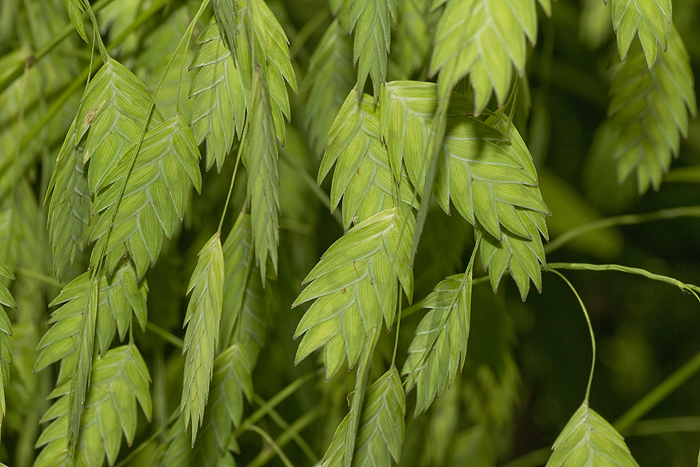 |
|
| |
The distinctive nodding seedheads of Northern Sea Oats |
|
Deschampsia flexuosa (Wavy Hair Grass) 
This is a cool season grass that needs a sandy soil which remains moist in spring. It will grow up to 3 feet in height and is particularly suited to lightly shaded acidic soil under pine trees.
| |
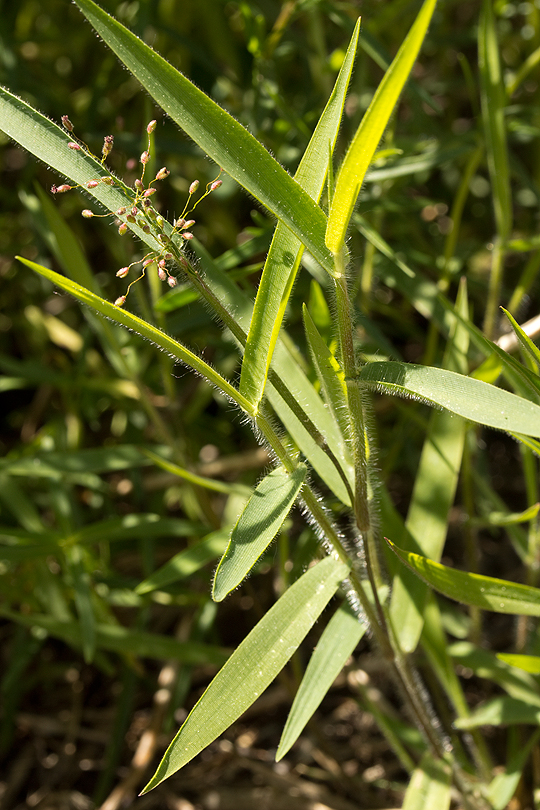 |
|
| |
Wooly panic grass is an excellent spring season grass for the front of the border |
|
Dichanthelium acuminatum (Woolly Panic Grass) 
This grass has similar growing conditions to Bromus kalmii. It only grows about 4 - 10 inches high and produces seeds that are enjoyed by birds. It would make an excellent grass at the front of the border and afternoon shade may keep it cool enough to grow throughout the summer. It used to be included in the genus Panicum and is considered to be a host for a wide range of skippers. Due to its short stature, it works incredibly well as an in between plant to provide cover as animals move around.
Dichanthelium depauperatum (Starved Panic Grass) 
This is another grass that does well in difficult sandy soils. It is a short grass barely exceeding one foot in height that is native to sandy savannahs and woodlands.
Elymus hystrix (Bottlebrush Grass) 
Bottlebrush Grass does well in moist loam soils and is one of the most shade tolerant plants in this category. It grows up to about four feet high with attractive growth and distinctive upright seed heads.
Elymus villosus (Silky Wild Rye) 
Silky Wild Rye prefers slightly drier habitats than Virginia Wild Rye where there are richer woodland soils. Like other Wild Rye, this is a cool season bunchgrass.
Elymus virginicus (Virginia Wild Rye) 
This plant is similar to Canadian Wild Rye, but it has upright seed heads and needs a moist soil to do well. It grows up to five feet high and it is a native of moist woodlands.
| |
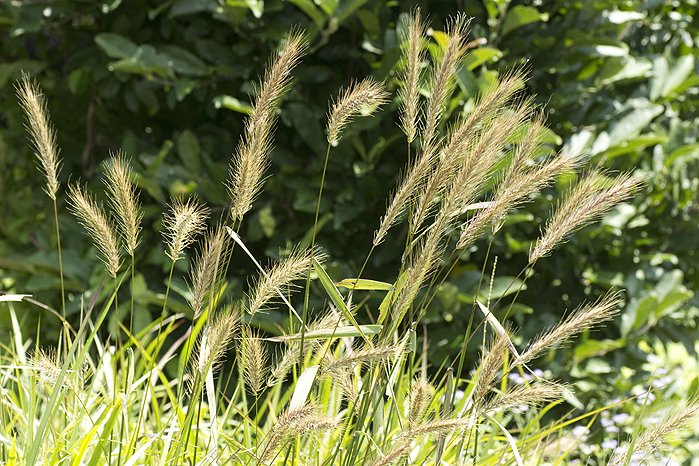 |
|
| |
The upright seedheads of Virginia Wild Rye. |
|
Luzula acuminata (Hairy Wood Rush) 
This is a cool season rhizomatous rush that is quite shade tolerant. The basal leaves remain evergreen throughout the winter. It needs moist and well drained soils to grow well and can be placed at the front of a border since it is only about 1 foot high. Part-sun is better for this plant than total shade.
Reference: Grasses, an identification guide (1979) by L. Brown
Reference Native Ferns Moss and Grasses (2008) by W. Cullina.



